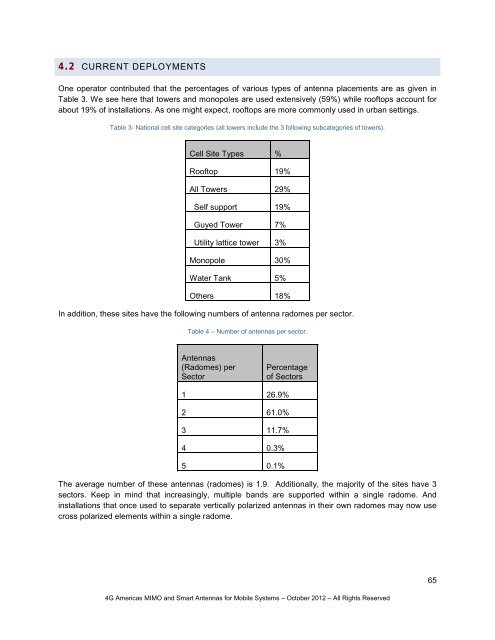MIMO and Smart Antennas for Mobile Broadband ... - 4G Americas
MIMO and Smart Antennas for Mobile Broadband ... - 4G Americas
MIMO and Smart Antennas for Mobile Broadband ... - 4G Americas
You also want an ePaper? Increase the reach of your titles
YUMPU automatically turns print PDFs into web optimized ePapers that Google loves.
4.2 CURRENT DEPLOYMENTSOne operator contributed that the percentages of various types of antenna placements are as given inTable 3. We see here that towers <strong>and</strong> monopoles are used extensively (59%) while rooftops account <strong>for</strong>about 19% of installations. As one might expect, rooftops are more commonly used in urban settings.Table 3- National cell site categories (all towers include the 3 following subcategories of towers).Cell Site Types %Rooftop 19%All Towers 29%Self support 19%Guyed Tower 7%Utility lattice tower 3%Monopole 30%Water Tank 5%Others 18%In addition, these sites have the following numbers of antenna radomes per sector.Table 4 – Number of antennas per sector.<strong>Antennas</strong>(Radomes) perSectorPercentageof Sectors1 26.9%2 61.0%3 11.7%4 0.3%5 0.1%The average number of these antennas (radomes) is 1.9. Additionally, the majority of the sites have 3sectors. Keep in mind that increasingly, multiple b<strong>and</strong>s are supported within a single radome. Andinstallations that once used to separate vertically polarized antennas in their own radomes may now usecross polarized elements within a single radome.<strong>4G</strong> <strong>Americas</strong> <strong>MIMO</strong> <strong>and</strong> <strong>Smart</strong> <strong>Antennas</strong> <strong>for</strong> <strong>Mobile</strong> Systems – October 2012 – All Rights Reserved65
















